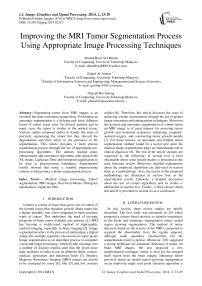Improving the MRI Tumor Segmentation Process Using Appropriate Image Processing Techniques
Автор: Ahmed Basil Al-Othman, Zohair Al-Ameen, Ghazali Bin Sulong
Журнал: International Journal of Image, Graphics and Signal Processing(IJIGSP) @ijigsp
Статья в выпуске: 2 vol.6, 2014 года.
Бесплатный доступ
Segmenting tumor from MRI images is an essential but time consuming manual duty. Performing an automatic segmentation is a defying task since different forms of tumor tissue exist for diverse patients and in many cases the tumor is similar to the normal tissue. Various studies proposed earlier to handle the issue of precisely segmenting the tumor but they discard the degradations and their effect to the precision of the segmentation. This article provides a more precise segmentation process through the use of appropriate pre-processing algorithms. The authors studied many enhancement and restoration algorithms and selected the NL-means, Laplacian filter and histogram equalization to be used as preprocessing techniques. Experimental results showed that using a suitable preprocessing scheme would produce a better segmentation process.
Medical image processing, Tumor segmentation, MRI images, Non-local Means, Histogram equalization, Laplacian filter
Короткий адрес: https://sciup.org/15013211
IDR: 15013211
Список литературы Improving the MRI Tumor Segmentation Process Using Appropriate Image Processing Techniques
- Chugh, S., & Anand, S. M. (2012). Semi-Automated Tumor Segmentation from MRI Images Using Local Statistics Based Adaptive Region Growing. International Journal of Information and Electronics Engineering, 2(1).
- Clark, M. C., Hall, L. O., Goldgof, D. B., Velthuizen, R., Murtagh, F. R., & Silbiger, M. S. (1998). Automatic tumor segmentation using knowledge-based techniques. Medical Imaging, IEEE Transactions on, 17(2), 187-201.
- Zhang, J., Zheng, J., & Cai, J. (2010, June). A diffusion approach to seeded image segmentation. In Computer Vision and Pattern Recognition (CVPR), 2010 IEEE Conference on (pp. 2125-2132). IEEE.
- Pizurica, A., Wink, A. M., Vansteenkiste, E., Philips, W., & Roerdink, B. J. (2006). A review of wavelet denoising in MRI and ultrasound brain imaging. Current medical imaging reviews, 2(2), 247-260.
- Noll, D. C., Pauly, J. M., Meyer, C. H., Nishimura, D. G., & Macovskj, A. (1992). Deblurring for non‐2D Fourier transform magnetic resonance imaging. Magnetic Resonance in Medicine, 25(2), 319-333.
- Al-Manea, A., & El-Zaart, A. (2007, January). Contrast enhancement of MRI images. In 3rd Kuala Lumpur International Conference on Biomedical Engineering 2006 (pp. 255-258). Springer Berlin Heidelberg.
- Rajendran, A., & Dhanasekaran, R. (2012). Brain Tumor Segmentation on MRI Brain Images with Fuzzy Clustering and GVF Snake Model. With Emphasis on the Integration of Three Technologies, 495.
- Zhang, J., Ma, K. K., Er, M. H., & Chong, V. (2004). Tumor segmentation from magnetic resonance imaging by learning via one-class support vector machine. In International Workshop on Advanced Image Technology (IWAIT'04) (pp. 207-211).
- M. Kumar and K. K. Mehta, “A Texture based Tumor detection and automatic Segmentation using Seeded Region Growing Method”, International Journal of Computer Technology and Applications, 2 (4), 2013.
- Faisal, A., Parveen, S., Badsha, S., Sarwar, H., & Reza, A. W. (2013). Computer Assisted Diagnostic System in Tumor Radiography. Journal of medical systems, 37(3).
- Afifi, A. (2012). A Hybrid Technique Based on Combining Fuzzy K-means Clustering and Region Growing for Improving Gray Matter and White Matter Segmentation. International Journal of Advanced Computer Science and Applications, 3(7).
- Efros, A. A., & Leung, T. K. (1999). Texture synthesis by non-parametric sampling. In Computer Vision, 1999. The Proceedings of the Seventh IEEE International Conference on (Vol. 2, pp. 1033-1038). IEEE.
- Buades, A., Coll, B., & Morel, J. M. (2004). On image denoising methods. CMLA Preprint, 5.
- Buades, A., Coll, B., & Morel, J. M. (2005, June). A non-local algorithm for image denoising. In Computer Vision and Pattern Recognition, 2005. CVPR 2005. IEEE Computer Society Conference on (Vol. 2, pp. 60-65).
- Mohanta, K., & Khanaa, V. (2013). An Efficient Contrast Enhancement of Medical X-Ray Images-Adaptive Region Growing Approach. International Journal of Engineering and Computer Science, 2(2).
- Umamaheswari, J., & Radhamani, G. (2012). An Enhanced Approach for Medical Brain Image Enhancement. Journal of Computer Science, 8(8), 1329.
- Kim, Y. T. (1997). Contrast enhancement using brightness preserving bi-histogram equalization. Consumer Electronics, IEEE Transactions on, 43(1), 1-8.
- Sapna Josephus, C., & Remya, S. (2012). Enhancement Techniques for Local Content Preservation and Contrast Improvement in Images.
- Goyal, S. (2011). ” Region Based Contrast Limited Adaptive HE with Additive Gradient for Contrast Enhancement of Medical Images (MRI)”. International Journal of Soft Computing and Engineering (IJSCE), 1(4).
- Menotti, D., Najman, L., Facon, J., & De Araujo, A. A. (2007). Multi-histogram equalization methods for contrast enhancement and brightness preserving. Consumer Electronics, IEEE Transactions on, 53(3).
- Al-Ameen, Z., Sulong, G. & Johar, M. G. M. (2012). A comprehensive study on fast image deblurring techniques. ”, International Journal of Advanced Science and Technology (IJAST), 44, 1-10.
- Deng, W., Xiao, W., Deng, H., & Liu, J. (2010, October). MRI brain tumor segmentation with region growing method based on the gradients and variances along and inside of the boundary curve. In Biomedical Engineering and Informatics (BMEI), 2010 3rd International Conference on (Vol. 1, pp. 393-396). IEEE.


